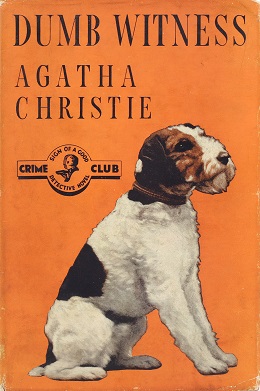„Niemy świadek”, Agatha Christie "Dumb Witness", Agatha Christie
Rodzinne konflikty to rzecz powszechna, każdemu dobrze znana. Zdarzają się z bardzo różnych powodów, także i tych związanych z finansami. Ale nie każdy konflikt kończy się śmiercią jednej ze stron, prawda? A tu właśnie tak było…
Emily Arundell jest bogatą starą panną mieszkającą w dużym domu w Anglii. Nigdy nie wzięła ślubu; w posiadłości poza nią i kilkorgiem służby mieszka tylko dama do towarzystwa – Wilhelmina Wilson, zwana Minnie. Ach nie! Jest też Bob, terier ostrowłosy. I właśnie Bob okaże się ważnym świadkiem wydarzeń, które doprowadzą do zgonu jego właścicielki… Ale zacznijmy od początku.
Musicie wiedzieć, że Emily była jedną pięciorga dzieci kapitana Arundella. Miała 3 siostry i brata. Teraz ta czwórka nie żyje, ale na świecie pozostało młode pokolenie:
- Bella – córka Arabelli, po której dostała imię. Poślubiła Greka, doktora Taniosa, i wyjechała z nim na Smyrnę. Ma dwoje małych dzieci.
- Theresa – córka Thomasa, jedynego brata Emily. Zaręczyła się z młodym, ambitnym doktorem Rexem Donaldsonem, partnerem lekarza leczącego pannę Arundell.
- Charles – brat Theresy.
Zarówno obie dziewczęta jak i młodzieniec znaleźli się w nagłej potrzebie; są, jak to się kolokwialnie mówi, „spłukani”. Jednak Emily zdecydowanie odmawia udzielania im pożyczek. Twierdzi, że mogą liczyć na swoje części jej fortuny kiedy ona już umrze i to powinno im wystarczyć.
Cała trójka – oraz mąż Belli Tanios – przyjeżdżają do posiadłości „cioci” na Wielkanoc. Po kolejnej nieudanej próbie wybłagania pożyczki, Charles sugeruje starej pannie, że powinna uważać, bo ktoś może zechcieć ją zabić. Następnie okrada krewną, zabierając pieniądze z szuflady w jej pokoju. A krótko potem zdarza się wypadek: panna Arundell, błąkając się po domu podczas bezsennej nocy, spada ze schodów. Nie robi sobie wielkiej krzywdy, ale wypadek jest dla niej pretekstem do przemyśleń. W prawdzie wszyscy mówią jej, że potknęła się na piłeczce pozostawionej przy najwyższym stopniu przez Boba, ale czy tak naprawdę było? Emily postanawia zmienić testament. Wydziedzicza zarówno Bellę, jak i oboje dzieci swojego brata, i zostawia cały majątek Minnie Wilson. Wysyła też list do Herkulesa Poirota, opisując swoje wątpliwości i prosząc o wyjaśnienie, kto mógłby chcieć ją zabić.
Niestety epistoła dochodzi do detektywa z opóźnieniem – dwa miesiące po tym, jak została napisana. Dlaczego Emily nie wysłała jej od razu? Poirotowi wydaje się to bardzo dziwne. Postanawia jak najszybciej odwiedzić starą pannę… i tu czeka go niemiła niespodzianka. Panna Emily Arundell nie żyje. Jak twierdzi jej lekarz, przyczyną zgonu były chroniczne problemy z wątrobą. Ale znów pojawia się pytanie: czy naprawdę tak było? Jego „małe szare komórki” podpowiadają detektywowi, że doszło do morderstwa. A jeśli tak, to kto był sprawcą?
W tym właśnie momencie wracamy do Boba. Pamiętacie wspomniany wcześniej wypadek? Pies NIE MÓGŁ zostawić piłeczki na szczycie schodów. Wieczorem przed feralną nocą wyszedł z domu i wrócił dopiero kilka godzin PO tym, jak Emily się potknęła. Starą pannę obudził głos Minnie, głośno narzekającej na konieczność otwarcia drzwi skomlącemu psu. Właśnie to wywołało w niej wątpliwości co do uczciwości jej krewnych. Dodatkowym śladem sugerującym morderstwo jest gwóźdź wbity w ścianę przy schodach i wzmianka służącej, że widziała na nim supełek z nici.
Jeśli kiedykolwiek mieliście styczność z książkami lub opowiadaniami o Herkulesie Poirot, to zapewne domyślacie się już, że i ta sprawa zakończy się dojściem prawdy. Pytanie nie brzmi więc: „Czy detektyw znajdzie sprawdzę i motyw zbrodni?” – lecz: „Jakim sposobem tym razem rozwiąże sprawę?” Przekonajcie się o tym sami, czytając książkę „Niemy świadek” Agathy Christie. Jest to jedna z tych lektur, od których ciężko się oderwać. Narracja prowadzona jest z perspektywy Arthura Hastingsa, przyjaciela głównego bohatera, i przeplatana jego komentarzami na temat działań detektywa. Po raz kolejny możemy przekonać się, czemu Poirot był od zawsze tak uwielbiany przez czytelników dzieł Agathy Christie, choć ona sama go nie lubiła. „Małe, szare komórki” znów go nie zawiodą… a zakończenie będzie niespodziewane.

Zdjęcie obwoluty pierwszego wydania w UK,
„Dumb Witness” (obrazek z Wikipedii)
Family conflicts are a common thing, well known to everyone. They happen for a variety of reasons, including those related to finance. But not every conflict ends in the death of one of the parties, right? And here it was so…
Emily Arundell is a rich spinster living in a large house in England. She has never married; apart from her and several servants, only a companion, Wilhelmina Wilson, called Minnie, lives in the estate. Ah no! There is also Bob, a fox terrier. And Bob will prove to be an important witness of events that will lead to the death of his owner… But let’s start from the beginning.
You must know that Emily was one of five children of Captain Arundell. She had 3 sisters and a brother. Now, these four are dead, but the young generation is left in the world:
- Bella – daughter of Arabella, after whom she got the name. She married the Greek, Dr Tanios, and went to Smyrna with him. She has two young children.
- Theresa – daughter of Thomas, Emily’s only brother. She got engaged to the young, ambitious Dr Rex Donaldson, partner of the doctor treating Miss Arundell.
- Charles – Theresa’s brother.
Both of the girls and the young man alike were in urgent need; they are, colloquially speaking, „broke”. However, Emily strongly refuses to grant them loans. She claims that they can count on their parts of her fortune when she dies and that should be enough for them.
All three of them – as well as Bella Tanios’s husband – come to the „auntie’s” estate for Easter. After another unsuccessful attempt to beg for the loan, Charles suggests to the old maiden that she should be careful because someone may want to kill her. Then he robs the relative by taking money from a drawer in her room. And shortly thereafter, an accident occurs: Miss Arundell, wandering around the house during a sleepless night, falls down the stairs. She doesn’t hurt herself a lot, but the accident is an excuse for her to think. In truth, everyone tells her that she stumbled over a ball left by Bob to the highest degree, but was it really so? Emily decides to change her will. She disinherits both Bella and both of her brother’s children and leaves all of her property to Minnie Wilson. She also sends a letter to Hercule Poirot, describing her doubts and asking for clarification as to who might want to kill her.
Unfortunately, the long detective arrives late – two months after it was written. Why didn’t Emily send her right away? It seems very strange to Poirot. He decides to visit the old lady as soon as possible… and here an unpleasant surprise awaits him. Miss Emily Arundell is dead. According to her doctor, the cause of death was chronic liver problems. But the question again arises: was it really that way? His „little grey cells” tell the detective that there was a murder. And if so, who was the perpetrator?
At this point, we are coming back to Bob. Do you remember the accident mentioned earlier? The dog COULD NOT have left the ball at the top of the stairs. In the evening before the unlucky night, he left the house and returned only a few hours AFTER Emily tripped. The spinster was awakened by the voice of Minnie, loudly complaining about the need to open the door for the whining dog. It was this that raised her doubts about the honesty of her relatives. An additional clue suggesting murder is a nail driven into the wall by the stairs and a mention of the maid that she saw a thread knot on it.
If you’ve ever had contact with books or stories about Hercule Poirot, you probably already guess that this case will end with the truth. So the question is not: „Will the detective find the perpetrator and motive of the crime?” – but: „How will he solve the case this time?” Find this out for yourselves by reading the book „Dumb Witness” by Agatha Christie. This is one of those readings that is hard to break away from. The narrative is conducted from the perspective of Arthur Hastings, a friend of the main character, and interspersed with his comments on the detective’s actions. Once again, we can see why Poirot has always been so adored by readers of Agatha Christie’s works, although she herself did not like him. The „little grey cells” will not disappoint him again… and the ending will be unexpected.
PS: Based on the book „Dumb Witness”, a two-part radio play was created. It was created for the needs of BBC Radio. You can listen to both parts here: https://www.youtube.com/watch?v=3P0uiQ0Jm74
„Dumb witness” – photo of the cover
of the Polish translation of the book
(private property)





